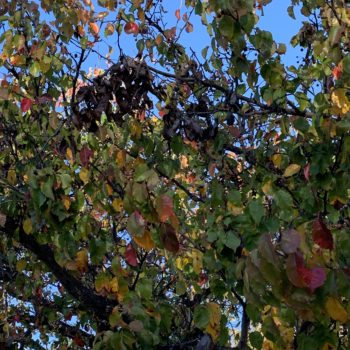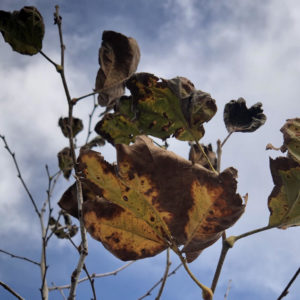Why Plant Health Care
By now, you should have plant health care (PHC) as part of your tree maintenance program. PHC can treat or prevent many of the diseases and pests that lead to Ugly Tree Syndrome, AKA whatever has made your tree’s leaves turn brown, black, spotted or fall off. If your tree is planted in an appropriate area and you are properly watering it, any out-of-season ugliness, nakedness or branch failure may be due to an underlying disease.
Don’t have a PHC program? Start here!
Timing is Everything
 Plant health care is an important piece of any tree maintenance plan, but like most things in life, timing is crucial. Applying a treatment at the wrong time can render it useless or even harmful. For example, applying fertilizer to a tree infected with a fungus will feed the disease and hurt the tree.
Plant health care is an important piece of any tree maintenance plan, but like most things in life, timing is crucial. Applying a treatment at the wrong time can render it useless or even harmful. For example, applying fertilizer to a tree infected with a fungus will feed the disease and hurt the tree.
Preventative treatments should be performed while the tree is dormant, before the new growth that stimulates the infection begins.
Fire Blight
 In our region, this nasty bacteria usually attacks the evergreen pear, a normally beautiful tree that is almost universally infected by fire blight in San Diego. Sadly, we have also begun to see it affect Bradford pears. You will notice signs of infection by clusters of brown, dead leaves in the tree’s canopy. The infection becomes active and spreads with new growth in the spring.
In our region, this nasty bacteria usually attacks the evergreen pear, a normally beautiful tree that is almost universally infected by fire blight in San Diego. Sadly, we have also begun to see it affect Bradford pears. You will notice signs of infection by clusters of brown, dead leaves in the tree’s canopy. The infection becomes active and spreads with new growth in the spring.
Therefore, treat evergreen pears before they bloom. We recommend treating between late January and early March.
Contact us NOW to get on the schedule.
Anthracnose
 Anthracnose is the name for a group of fungi that produce similar effects when attacking trees. If you have sycamores in San Diego, you are probably familiar with the symptoms of anthracnose and may even take them for granted.
Anthracnose is the name for a group of fungi that produce similar effects when attacking trees. If you have sycamores in San Diego, you are probably familiar with the symptoms of anthracnose and may even take them for granted.
Examine new leaves for yellow and brown spots that grow into large splotches and eventually cause the leaves to drop. The disease is not curable but it can be managed.
Anthracnose treatments are recommended between late January and early March, before the trees leaf out for the spring. They can also be applied to larger trees in the fall, before leaf drop.
Contact us NOW to schedule your trees.
